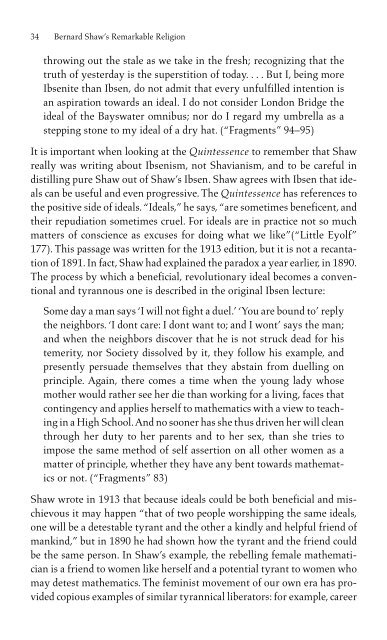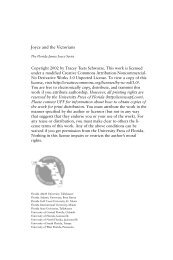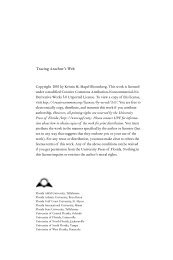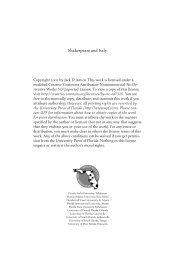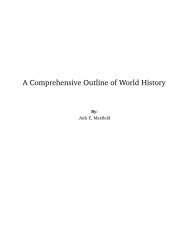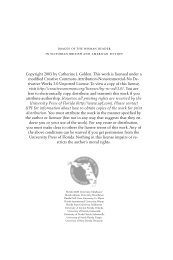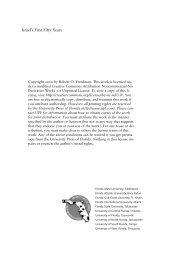Bernard Shaw's Remarkable Religion: A Faith That Fits the Facts
Bernard Shaw's Remarkable Religion: A Faith That Fits the Facts
Bernard Shaw's Remarkable Religion: A Faith That Fits the Facts
Create successful ePaper yourself
Turn your PDF publications into a flip-book with our unique Google optimized e-Paper software.
34 <strong>Bernard</strong> Shaw’s <strong>Remarkable</strong> <strong>Religion</strong><br />
throwing out <strong>the</strong> stale as we take in <strong>the</strong> fresh; recognizing that <strong>the</strong><br />
truth of yesterday is <strong>the</strong> superstition of today. . . . But I, being more<br />
Ibsenite than Ibsen, do not admit that every unfulfilled intention is<br />
an aspiration towards an ideal. I do not consider London Bridge <strong>the</strong><br />
ideal of <strong>the</strong> Bayswater omnibus; nor do I regard my umbrella as a<br />
stepping stone to my ideal of a dry hat. (“Fragments” 94–95)<br />
It is important when looking at <strong>the</strong> Quintessence to remember that Shaw<br />
really was writing about Ibsenism, not Shavianism, and to be careful in<br />
distilling pure Shaw out of Shaw’s Ibsen. Shaw agrees with Ibsen that ideals<br />
can be useful and even progressive. The Quintessence has references to<br />
<strong>the</strong> positive side of ideals. “Ideals,” he says, “are sometimes beneficent, and<br />
<strong>the</strong>ir repudiation sometimes cruel. For ideals are in practice not so much<br />
matters of conscience as excuses for doing what we like”(“Little Eyolf”<br />
177). This passage was written for <strong>the</strong> 1913 edition, but it is not a recantation<br />
of 1891. In fact, Shaw had explained <strong>the</strong> paradox a year earlier, in 1890.<br />
The process by which a beneficial, revolutionary ideal becomes a conventional<br />
and tyrannous one is described in <strong>the</strong> original Ibsen lecture:<br />
Some day a man says ‘I will not fight a duel.’ ‘You are bound to’ reply<br />
<strong>the</strong> neighbors. ‘I dont care: I dont want to; and I wont’ says <strong>the</strong> man;<br />
and when <strong>the</strong> neighbors discover that he is not struck dead for his<br />
temerity, nor Society dissolved by it, <strong>the</strong>y follow his example, and<br />
presently persuade <strong>the</strong>mselves that <strong>the</strong>y abstain from duelling on<br />
principle. Again, <strong>the</strong>re comes a time when <strong>the</strong> young lady whose<br />
mo<strong>the</strong>r would ra<strong>the</strong>r see her die than working for a living, faces that<br />
contingency and applies herself to ma<strong>the</strong>matics with a view to teaching<br />
in a High School. And no sooner has she thus driven her will clean<br />
through her duty to her parents and to her sex, than she tries to<br />
impose <strong>the</strong> same method of self assertion on all o<strong>the</strong>r women as a<br />
matter of principle, whe<strong>the</strong>r <strong>the</strong>y have any bent towards ma<strong>the</strong>matics<br />
or not. (“Fragments” 83)<br />
Shaw wrote in 1913 that because ideals could be both beneficial and mischievous<br />
it may happen “that of two people worshipping <strong>the</strong> same ideals,<br />
one will be a detestable tyrant and <strong>the</strong> o<strong>the</strong>r a kindly and helpful friend of<br />
mankind,” but in 1890 he had shown how <strong>the</strong> tyrant and <strong>the</strong> friend could<br />
be <strong>the</strong> same person. In Shaw’s example, <strong>the</strong> rebelling female ma<strong>the</strong>matician<br />
is a friend to women like herself and a potential tyrant to women who<br />
may detest ma<strong>the</strong>matics. The feminist movement of our own era has provided<br />
copious examples of similar tyrannical liberators: for example, career


